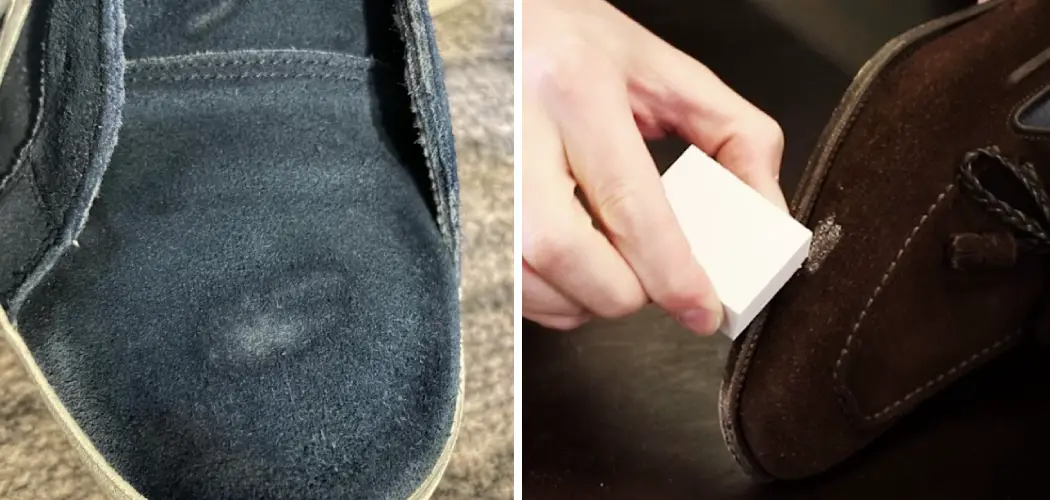Are you tired of seeing scuff marks on your suede shoes or jacket? A suede eraser may be just what you need! This rubber block is designed to remove scuff marks and stains from suede without damaging the delicate material. In this guide, we will explain how to use a suede eraser.

With its soft, luxurious texture, Suede is a popular material for shoes, jackets, and furniture, offering comfort and style. However, its delicate nature makes it prone to stains and scuffs, leaving many to wonder how to maintain its pristine condition. Enter the suede eraser—a simple yet effective tool designed to tackle these imperfections without the use of harsh chemicals.
In this guide, we’ll explore the straightforward process of using a suede eraser, ensuring your suede items remain in top-notch condition for years to come.
What are the Benefits of Using a Suede Eraser?
Before we dive into the specifics of using a suede eraser, let’s first understand its benefits. The primary advantage is that it effectively removes scuff marks and stains from suede without damaging or discoloring the material.
Additionally, it is a quick and easy solution for maintaining the appearance of your suede items. Unlike other cleaning methods that require time-consuming processes, a suede eraser can quickly remove marks and stains with minimal effort.
Moreover, suede erasers are relatively inexpensive and widely available at most shoe or leather stores. This makes it a cost-effective solution for maintaining the quality of your suede items without breaking the bank. Additionally, using a suede eraser allows you to avoid harsh chemicals that may be damaging to both the material and the environment.
What will You Need?
To begin using a suede eraser on your suede items, you will need the following:
- A Suede Eraser: is the primary tool for removing scuff marks and stains. It is made from a rubber-like material specifically designed to clean suede without damaging it.
- A Suede Brush: After using the suede eraser, you’ll need a suede brush to restore the material’s nap (suede’s soft, fuzzy surface). Suede brushes typically have soft bristles that are safe to use on the delicate surface.
- A Clean, Dry Cloth: This will be used to wipe down the suede before and after cleaning it with the eraser and brush. It helps remove any loose dirt or debris and prepares the surface for cleaning.
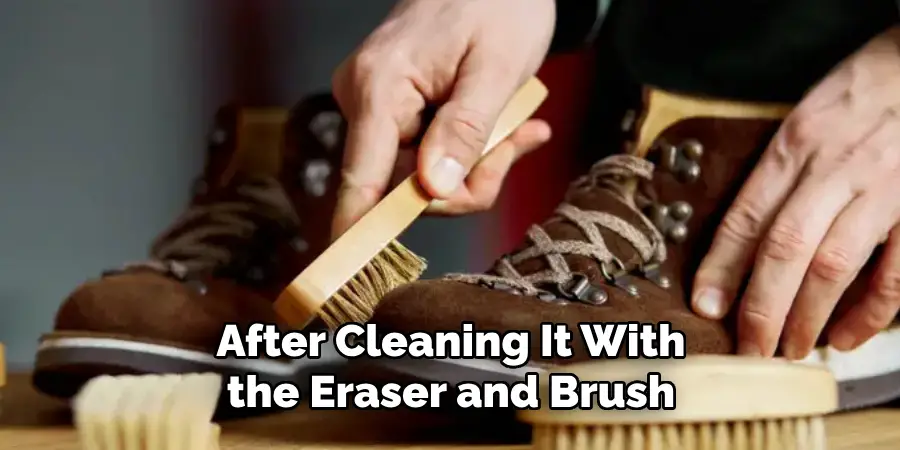
Gather these items before starting the cleaning process to ensure that you have everything you need at hand. This preparation will make the process smoother and more efficient, helping you maintain your suede items in pristine condition.
10 Easy Steps on How to Use a Suede Eraser
Step 1. Inspect the Suede:
Before starting the cleaning process, closely examine the suede item to identify all the scuff marks, stains, or areas that need attention. This step ensures that you don’t miss any spots during the cleaning process. Additionally, it allows you to determine the extent of the damage and how much effort is needed to restore its appearance.
Step 2. Brush Away Loose Dirt:
Using your suede brush, gently but firmly brush the surface of the item to remove any loose dirt, dust, or debris. This preliminary step is crucial as it prevents you from rubbing these particles into the suede while using the eraser, which could cause further stains or damage.
Move the brush in the direction of the suede’s grain to avoid disrupting the nap. This preparation not only cleans the surface but also helps in making the erasing process more effective and efficient.
Step 3. Gently Rub the Suede Eraser:
Use the suede eraser to gently rub over the scuff marks and stains on the suede. Apply a light to moderate pressure as you move the eraser back and forth over the affected areas.
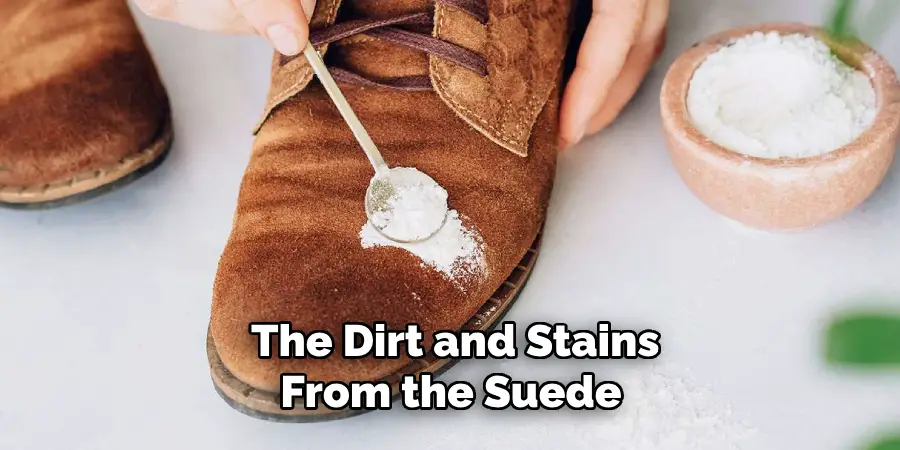
The eraser will crumble slightly as it lifts the dirt and stains from the suede. Continue this process until you notice the marks fading away. Remember to be patient and gentle to avoid damaging the material.
Step 4. Brush the Suede Again:
After using the suede eraser, take the suede brush once more and gently brush over the cleaned areas. This step is vital as it helps to lift the nap of the suede back to its original state, maintaining its soft, luxurious texture.
The brushing also removes any eraser residue from the suede, ensuring the surface is clean and smooth. Be sure to move the brush in the same direction as the suede’s grain to enhance the appearance and feel of the material.
Step 5. Wipe with a Clean, Dry Cloth:
Use a clean, dry cloth to gently wipe the suede surface after brushing. This step helps remove any remaining eraser debris and ensures that the surface is free of loose particles. It also aids in absorbing any excess moisture that may have accumulated during the cleaning process.
By doing this, you help to preserve the suede’s texture and appearance, ensuring that your item looks as good as new. Remember to use a soft cloth to avoid causing any unnecessary wear to the suede.
Step 6. Repeat if Necessary:
If any stains or scuff marks persist after the initial cleaning, repeat steps 3 through 5. Sometimes, tougher marks may require a couple of attempts before they lighten or disappear entirely.
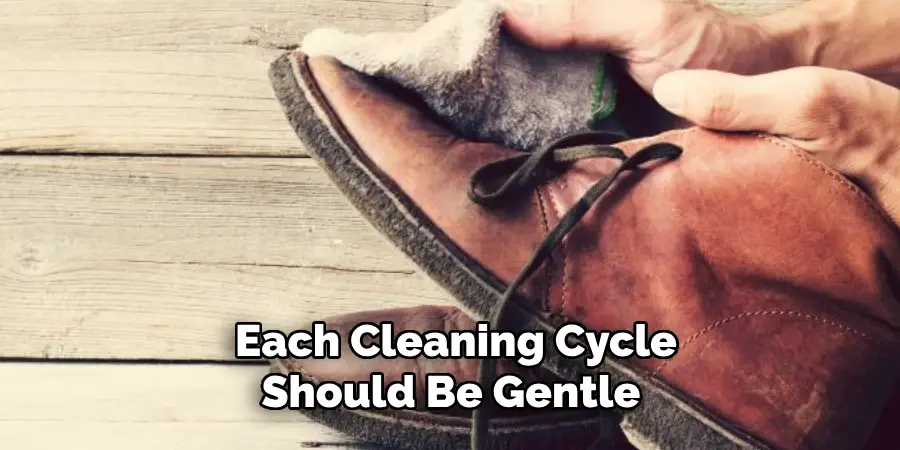
Ensure you’re patient through this process and avoid using excessive force to prevent damaging the suede. Each cleaning cycle should be gentle and methodical, focusing on gradually lifting the mark without compromising the material’s integrity.
Step 7. Allow the Suede to Dry Naturally:
After cleaning and wiping the suede, allowing the item to dry naturally in a well-ventilated area is important. Avoid direct heat sources or sunlight, as these can cause the suede to fade or warp.
Proper drying ensures that any moisture absorbed during the cleaning process evaporates completely, maintaining the suede’s optimal condition. This step is crucial in preserving the suede’s texture and preventing any water marks or stiffness that might result from improper drying.
Step 8. Protect Your Suede:
After the suede is completely dry, consider applying a suede protector. This product acts like a shield, repelling water and preventing stains from setting in the future. Spray the protector evenly over the suede from a distance of approximately 6 inches, ensuring complete coverage without saturating the material.
Allow the protector to dry completely before using or storing your suede item. Regular application of a suede protector can significantly extend the life and appearance of your suede, keeping it looking fresh and new for years to come.
Step 9. Proper Storage:
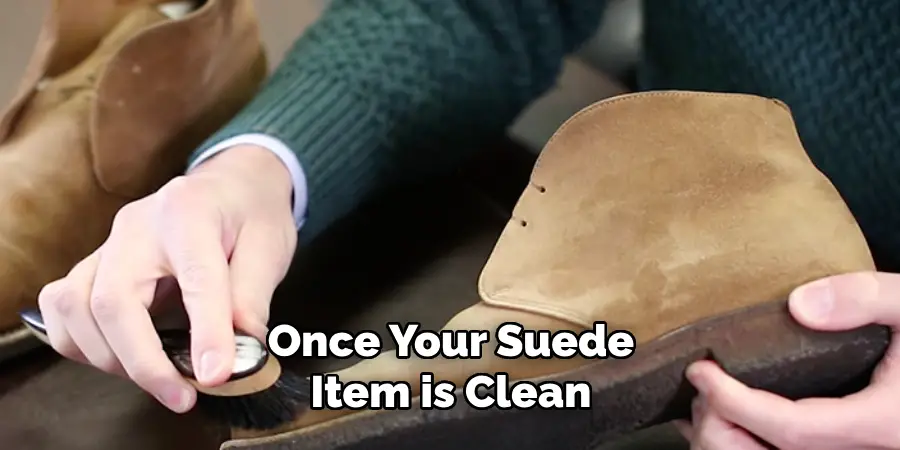
Once your suede item is clean, dry, and protected, it’s crucial to store it properly to maintain its condition. Avoid placing it in areas with high humidity or extreme temperature changes, as these can cause the suede to become stiff or moldy. Instead, opt for a cool, dry place where the suede can breathe.
If storing for a long period, consider using a breathable fabric bag instead of plastic, which can trap moisture. Proper storage will keep your suede looking great and extend its lifespan, ensuring it remains a cherished part of your wardrobe for years to come.
Step 10. Regular Maintenance:
To ensure your suede remains in top condition, incorporate regular maintenance into your care routine. Gently brush your suede items after each use to remove any surface dirt and to keep the nap vibrant and soft.
This prevents the accumulation of grime that can lead to more significant stains or damage over time. Additionally, reapply the suede protector every few months or more frequently if you use the item often. Regular maintenance not only keeps your suede looking its best but also minimizes the need for intensive cleaning sessions in the future.
By following these steps, you can quickly and effectively clean your suede items at home, saving yourself time and money. Remember to be gentle and patient during the process, as suede is a delicate material that requires care and attention.
5 Additional Tips and Tricks
1. Test on a Small Area First: Before you start cleaning the main stain or scuff, find a small, inconspicuous area on your suede item to test the suede eraser. This preliminary step ensures that the eraser does not alter the color or texture of the suede in an undesirable way. It’s a precaution to avoid causing more visible harm to your item.
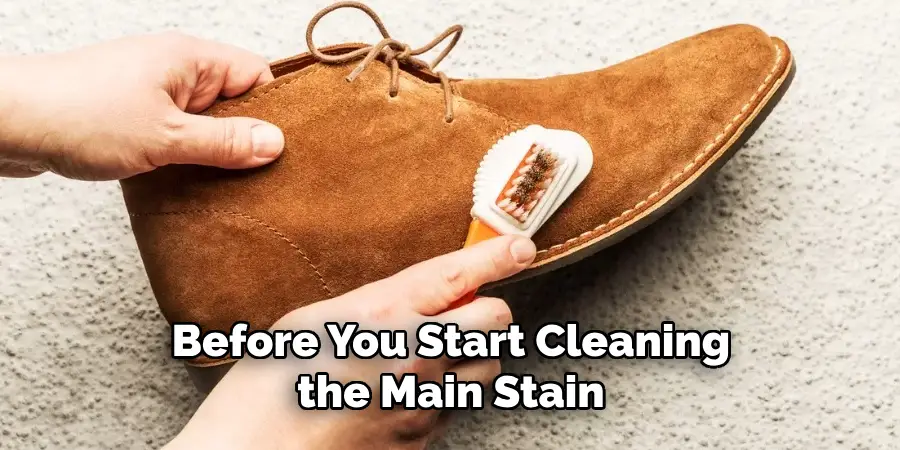
2. Use in Combination with Other Suede Care Products: For optimal results, complement the use of a suede eraser with other suede care products like a conditioning spray or foam. After erasing stains or scuffs, applying a conditioner can help restore the suede’s natural oils, keeping it soft and extending its lifespan.
3. Address Stains as Soon as Possible: The sooner you tackle a stain with your suede eraser, the better the outcome. Fresh stains are easier to lift off the surface before they have time to set deeply into the suede’s fibers. Prompt attention can save you time and minimize the need for repetitive cleaning efforts.
4. Apply Varying Pressure Based on the Stain’s Severity: Not all stains require the same amount of pressure. Start gently and increase the pressure only as needed for stubborn marks. This technique prevents unnecessary stress on the suede while ensuring that tougher stains receive the attention they need to be effectively removed.
5. Keep Your Suede Eraser Clean: After each use, be sure to clean your suede eraser by gently rubbing off the residue on a clean paper or cloth. An eraser clogged with dirt or suede particles won’t be as effective and can transfer residues back onto the suede. Keeping your eraser clean ensures it is ready for its next use and maintains its effectiveness.
By following these tips, you can get the most out of your suede eraser and keep your suede items looking their best.
5 Things You Should Avoid When Using a Suede Eraser
1. Excessively Wet Suede: Avoid using a suede eraser on overly wet suede. The eraser is designed for dry materials, and using it on wet suede can cause the suede fibers to mat, damaging the nap and texture. Always allow suede to dry naturally before attempting to erase any marks.
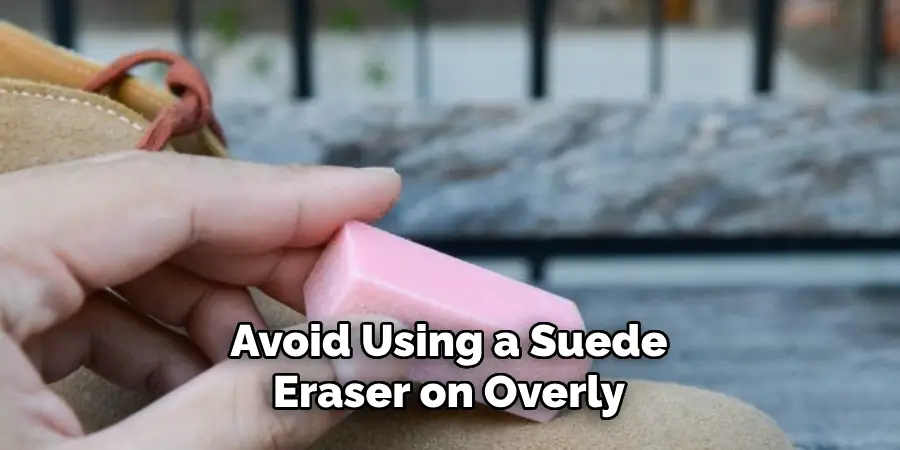
2. Harsh Scrubbing: While it may be tempting to scrub vigorously on stubborn stains, doing so can damage the delicate fibers of the suede. Instead, use gentle motions and gradually increase pressure as needed, being mindful not to harm the material.
3. Using a Dirty Eraser: A suede eraser filled with debris from previous cleanings can transfer that dirt back onto your suede item, potentially causing more staining. Keep your eraser clean by brushing off the residue regularly.
4. Ignoring Manufacturer’s Instructions: Suede erasers may have specific instructions regarding their use on different suede textures or colors. Ignoring these guidelines can lead to damage. Always read and follow the manufacturer’s recommendations.
5. Using on Non-Suede Materials: Suede erasers are specifically designed for suede and may not be suitable for use on other materials like nubuck or smooth leather. Using the eraser on inappropriate materials can cause damage, so it’s essential to verify compatibility before use.
By following these precautions, you can safely and effectively use a suede eraser without risking damage to your suede items.
What is the Difference Between a Suede Eraser and a Regular Eraser?
A suede eraser and a regular eraser share the primary function of removing marks, but they are designed for different materials and serve distinctive purposes.
A suede eraser is specifically crafted to address the unique needs of suede, a delicate material with a soft, napped surface. It gently lifts and removes dirt, stains, and scuffs from the suede without damaging its texture.
Conversely, a regular eraser, typically used for erasing pencil marks on paper, has a harder composition and lacks the softness required to clean suede without harming it. The formulation of a suede eraser allows it to crumble as it lifts dirt, which is key to its effectiveness on suede items.
Attempting to use a regular eraser on suede can result in damage to the suede’s nap and may not effectively remove stains or scuffs, highlighting the importance of using the correct type of eraser for suede care.
Can I Use a Pencil Eraser as a Suede Eraser?
While pencil erasers may seem similar to suede erasers, they are not interchangeable. Pencil erasers are designed for a different purpose and have a different composition than suede erasers.
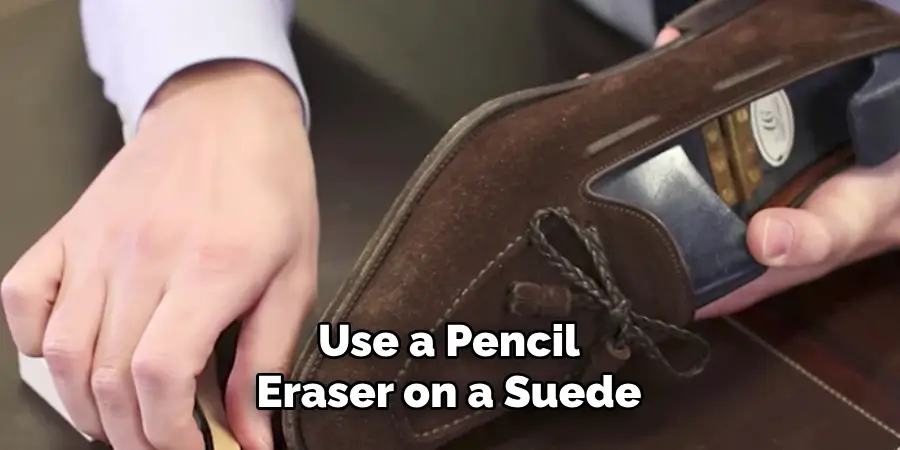
Attempting to use a pencil eraser on a suede can lead to damage or transfer of the graphite from the pencil onto the suede, creating more cleaning work. It is best to stick with a specifically designed suede eraser for optimal results and safe care of your suede items.
Additionally, suede erasers come in various shapes and sizes, making it easier to navigate hard-to-reach areas or clean specific types of stains. Pencil erasers do not have the same versatility as suede erasers, further highlighting the importance of using a suede eraser for suede care.
In conclusion, while both pencil erasers and suede erasers may share some similarities, they are not interchangeable. It is essential to use the correct type of eraser for suede items to avoid damage and achieve optimal results.
Does Suede Eraser Remove Water Stains?
Yes, suede erasers can remove water stains on suede items. Water stains on suede are typically caused by excess moisture or spills that have yet to be promptly addressed. These stains can leave a darkened spot on the suede’s surface and may require extra attention to remove.
Using a suede eraser is an effective way to lift these water stains from the suede without causing damage to the material. However, it is crucial to follow the recommended steps for cleaning water stains on suede, which may include using a gentle cleanser or conditioner after erasing the stain.
Prevention is also key in avoiding water stains on suede items. Treating your suede with a protective spray can help repel moisture and prevent staining. Additionally, prompt attention to spills or moisture can prevent the formation of water stains, reducing the need for erasing in the first place.
Conclusion
In summary, a suede eraser is an invaluable tool for the care and maintenance of suede items, helping to keep them looking pristine and prolonging their life. By understanding and applying the proper technique—test on a small area, address stains promptly, apply varying pressure based on the stain’s severity, and maintain the eraser clean—you can effectively use a suede eraser to tackle many common suede problems.
However, it’s essential to remember the precautions, such as avoiding the use of excessively wet suede, using gentle motions to avoid damaging the nap, and adhering to the manufacturer’s instructions to ensure the best results. With these guidelines in mind, anyone can master the use of a suede eraser, ensuring their suede items remain in top condition for years to come.
Hopefully, this guide on how to use a suede eraser has provided valuable information on the dos and don’ts of using a suede eraser, making it easier for you to keep your suede items in pristine condition. With proper care and maintenance, your favorite suede pieces can remain looking as good as new for years to come!

